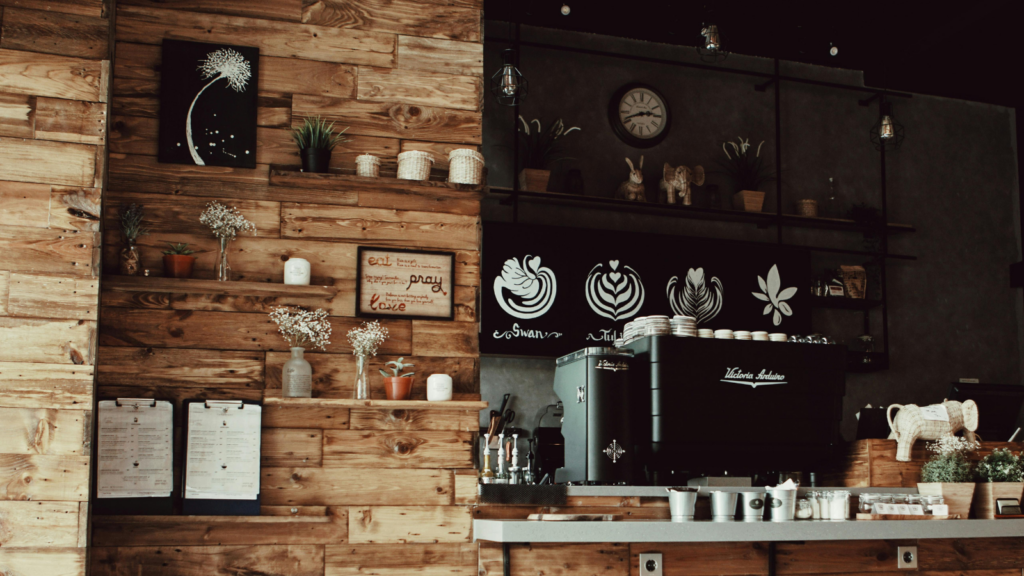Stepping into a coffee shop, it’s often the ambiance that first captures your attention. The interior design plays a pivotal role in creating that perfect environment for savoring a cup of coffee. It’s not just about aesthetics, but also about creating a space that tells a story, evokes emotions, and enhances the overall coffee-drinking experience.
From the choice of furniture to the color scheme, every detail matters in coffee shop interior design. It’s a fascinating blend of art and business strategy, where the design elements are carefully curated to attract customers, retain them, and ultimately drive sales. This article delves into the intriguing world of coffee shop interior design, offering insights that could inspire your next design project.
Coffee Shop Interior Design
Diving into coffee shop interior design, one encounters a world of strategic decision making. Every detail matters. Furniture choices impact the venue’s comfort and style, while color schemes can stimulate or calm patrons’ moods.
An essential aspect, lighting, sets the tone, whether it’s romantic low-light or a vibrant, bright ambience. Varied seating options accommodate different customers: those desiring solitude, groups meeting for a chat or someone settling in for long hours of work.

The bar or counter, apart from being functional, serves as a visual centerpiece. Creatively showcasing the coffee-making process — from grinding beans to brewing — can arouse interest and convey freshness.
Intricate wallpaper designs or artistic blackboards can breathe life into walls, and curated music playlists contribute towards shaping the mood and energy. The subtle choices in coffee shop interior design help stitch a memorable experience for customers and a thriving space for business.
Case Studies: Successful Coffee Shop Interior Designs
Dishing up three delectable case studies, it’s clear successful coffee shop interior designs serve a potent brew of aesthetic appeal, functionality, and strategic storytelling. Across the globe, coffee shops such as ‘Coffee Collective,’ ‘Starbucks Reserve Roastery,’ and ‘Ipsento 606’ showcase interior design tactics that rightly deserve acclaim.
Coffee Collective, Copenhagen: Celebrates Scandinavian design principles. Its minimalistic style focuses predominantly on functionality, emphasizing the connection between the space and its users. Natural materials, abundant daylight, and muted color schemes contribute to an inviting, comfortable environment.

Starbucks Reserve Roastery, Seattle: Showcases transparency in the coffee-making process. The immersive, theatrical design features a two-story copper cask, coffee makers operating in an open layout, and design elements reflecting Seattle’s maritime history. This flagship store sets new standards for coffee shop interior designs.
Ipsento 606, Chicago: Prioritizes community interaction. An open floor plan, combined with innovative tiered seating, promotes conversation among customers. Its use of warm-colored wood, industrial concrete, and ample natural light creates a welcoming, cozy atmosphere.
Trends in Coffee Shop Interior Design
Coffee shop interior design landscape thrives on evolving trends, mirroring customer preferences and market dynamics. It seems industrial themes lead the pack, bringing in elements like exposed brickwork, concrete floors, and steel fixtures to convey an edgy, rustic charm. Transforming into artsy havens, some cafes adopt a bohemian flair, combining eclectic furnishings with vibrant colors and patterns. Minimalistic Scandinavian designs gain momentum, presenting clean lines, earthy tones, and a focus on functionality. Traditional looks persist too, featuring cozy seating, warm lighting, and antique pieces that harken back to old-world charm.
Others explore biophilic designs, fostering connections with nature via incorporation of indoor plants, wooden structures, and natural light. Flexibility rings key in recent designs, using moveable partitions and multi-use furniture to cater to varying customer needs. Tech-integrated designs make headway,

offering mobile charging ports, high-speed Wi-Fi, and interactive touchscreens. Sustainability underpins many modern designs, relying on recycled materials, solar energy, and waste reduction strategies. Lastly, displaying the coffee-making process transparently, also known as “coffee theater,” captivates patrons, turning a simple café visit into an immersive experience. One effective way to showcase this experience is by creating a video with a video editing tool. Highlighting the ambiance, the craftsmanship, and the unique features of your café through video can attract a wider audience. You can seamlessly edit clips of your baristas at work, customers enjoying their coffee, and the overall aesthetic of your coffee shop. This not only engages your viewers but also reinforces your brand identity and helps potential patrons visualize the experience they can expect. Careful observation of these trends can inspire coffee shop interior designers to create spaces that resonate with target demographics while reinforcing their brand identity.
Solid Take on Coffee Shop Interior Design
The interior design of a coffee shop isn’t just about aesthetics; it’s a powerful tool that shapes customer experiences and drives sales. From the furniture and lighting to the bar design and visual displays, every detail plays a part in creating a unique ambiance. Trends are ever-evolving, with industrial, bohemian, and Scandinavian styles leading the way, and the incorporation of biophilic elements is gaining traction.
